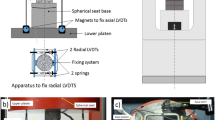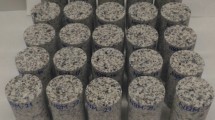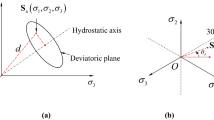Abstract
We propose a method for identifying a three-dimensional strain tensor using six or more strain gauges. This purely theoretical method assumes elementary deformation of the target object. To derive the strain tensor, six independent strain components must be measured using six or more strain gauges. The effect of measurement errors of the strain gauges on the strain tensor varies with the arrangement and orientations of the strain gauges. Thus, we also propose a method for evaluating the quality of the arrangement and orientations of the strain gauges. In this evaluation method, the determinant and condition number \(\kappa\) of the matrix obtained from the unit direction vector in the attachment direction of the strain gauge are analyzed. The quality of each strain gauge arrangement is evaluated based on an assumption of 2–4 rosette gauges attached to a cylindrical specimen. The results of the proposed numerical analysis demonstrated that it is disadvantageous to install strain gauges at axisymmetric positions, and that it is better to have strain gauges attached to the sides in different directions. Furthermore, to evaluate one of the methods verified in this analysis, a triaxial compression test of Neogene-period tuff was conducted for comparison. It was determined that the strain tensor can be specified with high accuracy even though the three-rosette-gauge method had a medium accuracy. The accuracy improved as the number of strain gauges increased, and it was demonstrated that the strain tensor could be identified with sufficient accuracy even when only three rosette gauges are used.
Highlights
-
A theoretical method for measuring strain tensor is proposed.
-
Strain tensor is obtained from normal strain components measured by strain gauges.
-
The method was experimentally validated via comparison with triaxial tests.
-
Arrangements of strain gauges that stably identify the strain tensor were determined.









Similar content being viewed by others
References
Allirot D, Boehler JP, Sawczuk A (1977) Irreversible deformations of an anisotropic rock under hydrostatic pressure. Int J Rock Mech Min Sci 14(2):77–83. https://doi.org/10.1016/0148-9062(77)90199-1
Amadei B (1996) Importance of anisotropy when estimating and measuring in situ stresses in rock. Int J Rock Mech Min Sci 33(3):293–325. https://doi.org/10.1016/0148-9062(95)00062-3
Dambly MLT, Nejati M, Vogler D, Saar MO (2019) On the direct measurement of shear moduli in transverse isotropic rocks using the uniaxial compression test. Int J Rock Mech Min Sci 113:220–240. https://doi.org/10.1016/j.ijrmms.2018.10.025
Goodman RE (1989) Introduction to rock mechanics, 2nd edn. Wiley, New York
Japanese Geotechnical Standard (JGS) (2020a) Method for in-situ triaxial compression test on rocks. Japanese Geotechnical Society. JGS3541-2020
Japanese Geotechnical Standard (JGS) (2020b) Method for in-situ direct tension test on rocks. Japanese Geotechnical Society. 2020;JGS3551-2020
Kreyszig E (1978) Introductory functional analysis with applications. Wiley, New York
Kreyszig E (2011) Advanced engineering mathematics, 10th edn. Wiley, Asia
Lin W, Sugimoto T, Nagano Y, Tsusaka K (2017) Application of core-based stress measurement methods: for determining optimum hydraulic fracturing parameters. J Japan Assoc Pet Technol 82(6):428–437 (In Japanese)
Matsuki K, Takeuchi K (1993) Three-dimensional in situ stress determination by anelastic strain recovery of a rock core. Int J Rock Mech Min Sci 30(7):1019–1022. https://doi.org/10.1016/0148-9062(93)90064-K
Sakaguchi K, Yokoyama T, Lin W, Watanabe N (2017) Stress buildup and drop in inland shallow crust caused by the 2011 Tohoku-oki earthquake events. Sci Rep 7(10242):1–8. https://doi.org/10.1038/s41598-017-10897-8
Togashi Y, Kikumoto M, Tani K (2017) An experimental method to determine the elastic properties of transversely isotropic rocks by a single triaxial test. Rock Mech Rock Eng 50(1):1–15. https://doi.org/10.1007/s00603-016-1095-9
Togashi Y, Kikumoto M, Tani K, Hosoda K, Ogawa K (2018a) Detection of deformation anisotropy of tuff by a single triaxial test on a single specimen. Int J Rock Mech Min Sci 108:23–36. https://doi.org/10.1016/j.ijrmms.2018.04.054
Togashi Y, Kikumoto M, Tani K (2018b) Determining anisotropic elastic parameters of transversely isotropic rocks through single torsional shear test and theoretical analysis. J Petrol Sci Eng 169:184–199. https://doi.org/10.1016/j.petrol.2018.05.051
Togashi Y, Kikumoto M, Tani K, Hosoda K, Ogawa K (2021a) Determination of 12 orthotropic elastic constants for rocks. Int J Rock Mech Min Sci 147. https://doi.org/10.1016/j.ijrmms.2021.104889
Togashi Y, Imano T, Osada M, Hosoda K, Ogawa K (2021b) Principal strain rotation of anisotropic tuff due to continuous water-content variation. Int J Rock Mech Min Sci 138. https://doi.org/10.1016/j.ijrmms.2021.104646
Togashi Y, Imano T, Osada M (2021) Deformation characteristics of sedimentary rock due to continuous changes of moisture content in wetting process. IOP Conf Ser Earth Environ Sci 703(1):1. https://doi.org/10.1088/1755-1315/703/1/012021
Yokoyama T (2017) Current status and standardization of initial stress measurement techniques. OYO Corp Tech Rep 36:71–91 (In Japanese)
Voight B (1968) Determination of the virgin state of stress in the vicinity of a borehole from measurements of a partial anelastic strain tensor in drill cores. Rock Mech Eng Geol 6(4):201–215
Author information
Authors and Affiliations
Corresponding author
Additional information
Publisher's Note
Springer Nature remains neutral with regard to jurisdictional claims in published maps and institutional affiliations.
Appendix
Appendix
Calculations for two examples of matrices are demonstrated here to clarify the good and ill conditions of matrices for solving simultaneous linear equations (Kreyszig 2011). An example of a good-condition matrix is
where \(\epsilon\) is a small error. This equation can be transformed using det\({\varvec{A}}\), as follows:
For this equation, det\({\varvec{A}}=2\), and both the \(l_1\) and \(l_\infty\) norms for \({\varvec{A}}\) have a value of \(\kappa ({\varvec{A}}) =||{\varvec{A}}||~||{\varvec{A}}^{-1}||=2\). For a good-condition matrix, the values of det and \(\kappa\) should not be small. The solutions of this equation are \(y_1=0.5\epsilon\) and \(y_2=-1-0.5\epsilon\). The correct solutions of this equation without error are \(y_1=0\) and \(y_2=-1\). Therefore, this equation is not affected by a small error \(\epsilon\).
On the other hand, an example of an ill-condition matrix is
where \(\epsilon\) is a similarly small error. This equation can be transformed to
For this equation, det\({\varvec{B}}=0.0002\), and both the \(l_1\) and \(l_\infty\) norms for \({\varvec{B}}\) have a value of \(\kappa ({\varvec{B}}) =||{\varvec{B}}||~||{\varvec{B}}^{-1}||= 20001\). For an ill-condition matrix, the value of det should be much smaller, and the value of \(\kappa\) should be much larger than that of a good-condition matrix. The solutions of this equation are \(y_1=0.5 + 5000.5\epsilon\) and \(y_2=-0.5-4999.5\epsilon\). The correct solutions of this equation without error are \(y_1=0.5\) and \(y_2=-0.5\). Therefore, this equation is significantly affected by a small error \(\epsilon\). The influence of error on the solutions is 10000 times greater than that for the good-condition matrix.
Rights and permissions
About this article
Cite this article
Kikumoto, M., Togashi, Y. Method for Measuring Three-Dimensional Strain Tensor of Rock Specimen Using Strain Gauges. Rock Mech Rock Eng 55, 4093–4107 (2022). https://doi.org/10.1007/s00603-022-02849-0
Received:
Accepted:
Published:
Issue Date:
DOI: https://doi.org/10.1007/s00603-022-02849-0




